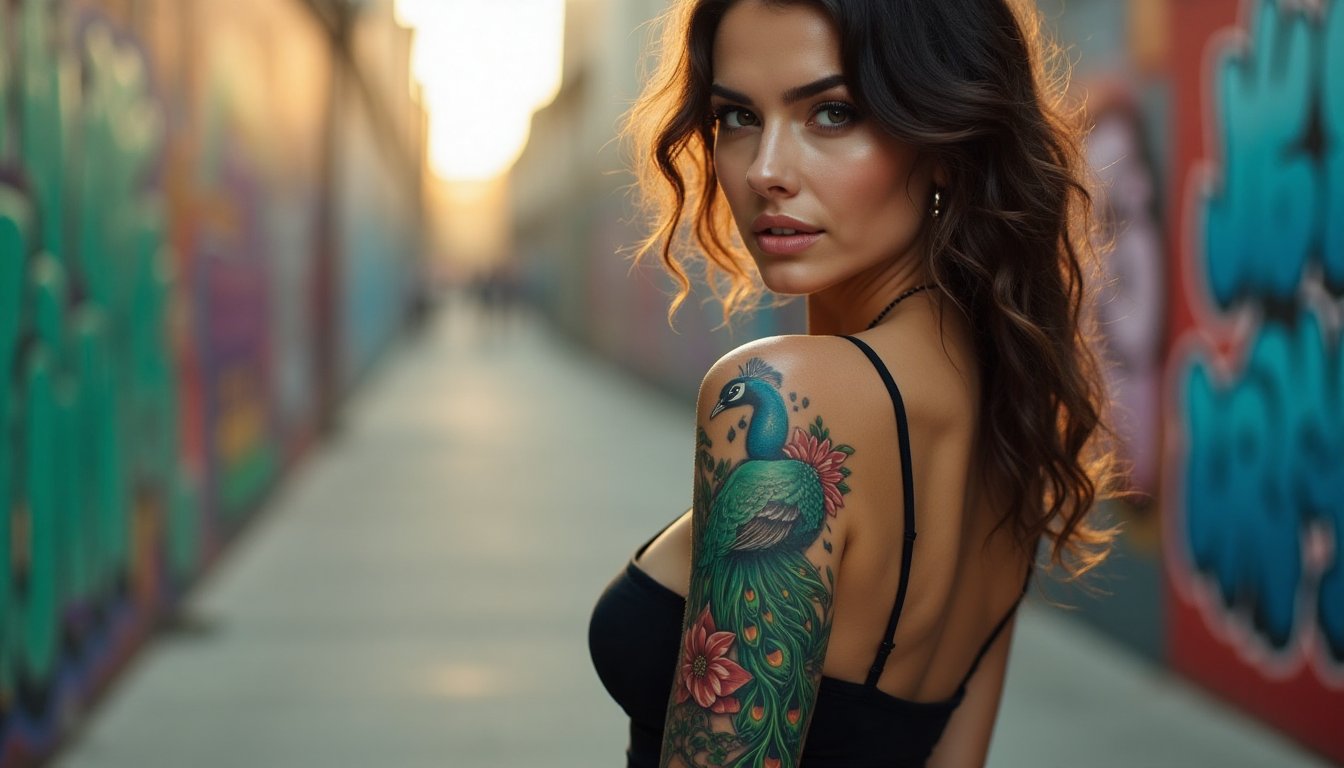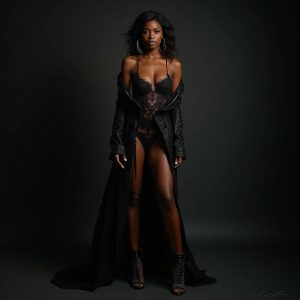The Inked Journey: Celebrating Tattoo Artistry, Identity, and Emotion
In the heart of a vibrant urban street art district, a captivating woman catches the eye. She stands confidently, her form-fitting attire accentuating her hourglass figure. The backdrop is a kaleidoscope of color—the graffiti murals vibrate with life, telling stories of rebellion, dreams, and cultural heritage. Yet, it’s her right arm that truly mesmerizes the observer. There, a stunning sleeve tattoo unfolds; a majestic peacock graces her skin, feathers dancing from vivid greens to deep blues. Each feather transforms into intricate floral motifs, symbolizing beauty, identity, and evolution. As the late afternoon sun sets, it casts a warm glow over the scene, making it feel alive, as if the art itself breathes.
This enchanting encounter is only one example of how tattoos function as powerful expressions of one’s self. Tattoos are more than just ink on skin; they embody personal stories, cultural connections, and emotional journeys. Join me as we dive into the fascinating world of tattoos and tattoo artistry, exploring its challenges, misconceptions, and the immense beauty within.
Tattoos and Identity: A Canvas of Self-Expression
Tattoos have long had a complex relationship with identity. For centuries, they have been used to signify status, commemorate events, and express individuality. In many cultures, they serve as rites of passage or marks of belonging. As tattoo artist Kat Von D famously said, “Tattoos are like a diary written on your skin.” Each tat tells a unique story and reflects the wearer’s journey through life.
Take clients like James, who tattooed a simple yet profound phrase on his forearm: “This too shall pass.” This ink serves as a personal mantra for him, a constant reminder to embrace change and resilience through life’s highs and lows. It’s a powerful sentiment that resonates with many. Similarly, Michelle, a survivor of breast cancer, chose a phoenix tattoo to symbolize her rebirth after battling the disease, the vibrant colors reflecting her newfound hope and strength. For her, the ink is not just a design; it’s a celebration of survival and courage.
Through these stories, we see how tattoos illuminate our struggles, triumphs, and aspirations—transforming skin into meaningful canvases rich with narratives.
The Artistry Behind the Ink: Dedication and Creativity
Imagine the life of a tattoo artist, a creative soul dedicated to transforming skin into living, breathing masterpieces. Tattooing requires not only artistic skill but also a deep understanding of human anatomy, psychology, and connection. Artists like Sasha Unisex have carved out a niche in the world of tattoos, becoming known for her vibrant watercolor designs that fuse nature with abstract forms.
“It’s about the story behind the tattoo,” Sasha says. “Every piece is a collaboration between me and my client.” Her approach exemplifies the unique partnership between artist and wearer—creating art that not only looks beautiful but also resonates deeply with the individual. Each stroke of the needle is intentional and filled with meaning, capturing the essence of who the person is or aspires to be.
While tattooing is undeniably a form of art, it also brings with it a myriad of challenges. Misconceptions about tattooing frequently pervade the culture. Many people still view it as rebellious or unprofessional, leading to prejudice in workplaces and society at large. Yet, as tattoo culture evolves, so do perceptions. The growing acceptance of tattoos reflects a broader societal shift toward authenticity and personal expression.
Navigating Misconceptions: The Changing Landscape of Tattoo Culture
The proliferation of tattoos in popular culture—from celebrities flaunting their ink to major fashion runways embracing tattooed models—has opened new conversations about identity and acceptance. Yet, misconceptions persist. Some still believe that tattoos reflect poor decision-making or rebellion, failing to see the beauty and thoughtfulness behind each piece.
In a Pew Research Study, 38% of adults aged 18–29 reported having at least one tattoo, dispelling the myth that tattoos are merely for the young or those seeking attention. Tattoos today have permeated all demographics; they serve as markers of personal life stories rather than acts of defiance.
Despite changing societal views, tattoo artists often face biases when seeking professional recognition. Some hold back from pursuing opportunities in more corporate environments, fearing that their artistry may be dismissed. But as more individuals choose tattoos to signify their career achievements, we might see a culture shift where body art becomes a celebrated form of self-expression rather than a barrier.
The Emotional Impact: Healing, Connection, and Belonging
The relationship between tattoo artists and their clients often transcends the physical act of tattooing. For many, a tattoo symbolizes healing after trauma. Roughly 70% of clients report that their tattoos act as therapeutic tools, helping them work through personal struggles and painful experiences. Artists like Dr. Woo strive to create an environment of comfort and trust, recognizing that clients bare not only their skin but also their souls in the tattoo chair.
Consider Emily, who chose to tattoo over a scar from a car accident. “It turned the painful reminder into something beautiful,” she recounts. “Every time I look at it, I remember how far I’ve come.”
Tattooing fosters connections between people—an act of intimacy that often leads to deep friendships between artists and clients. The shared experience of ink can build trust and understanding, allowing those involved to form bonds that might not have existed otherwise. These relationships reinforce the idea that tattoos are not just about the ink. They encapsulate stories of love, loss, and resilience, creating a tapestry of shared human experiences.
The Future of Tattoos: Embracing Change
As we look to the future, the tattoo industry will likely continue to evolve. Innovations in technology—like 3D printing and biofeedback-assisted tattooing—hold exciting potential for customization and artistry. Studies are also emerging on skin as a canvas, exploring how tattoos can serve medical and revitalizing purposes.
Moreover, social media will keep providing tattoo artists with platforms to showcase their work, build connections, and educate others about the craft. Artists can now share their techniques on platforms like Instagram, allowing them to inspire a new generation of tattoo enthusiasts who appreciate the artistry and depth behind the ink.
Final Thoughts: Inked Stories for a Tapestry of Humanity
This lively exploration of the tattoo world reveals that tattoos are profound expressions of identity, creativity, and emotion. They tell our stories, celebrate our journeys, and invite others to connect with us on a deeper level. The journey of tattoo artistry is not only about the ink that adorns our skin but also about the shared human experience—the joys, triumphs, and sorrows that unite us all.
So let me ask you: What does your body art say about you? If you’re considering a tattoo, what story do you want to tell through your ink? I invite you to share your experiences and thoughts in the comments below.
If you want to stay in the loop about the latest in tattoo trends, artistry, and stories, don’t forget to subscribe to our newsletter and become a permanent resident of iNthastyle: the “Fashion’s City on the Web”. Let’s share in the vibrant community celebrating tattoos, color, and the beautiful tapestry of life!
Disclaimer: This article may contain affiliate links. If you click on these links and make a purchase, we may receive a commission at no additional cost to you. Our recommendations and reviews are always independent and objective, aiming to provide you with the best information and resources.
Get Exclusive Stories, Photos, Art & Offers - Subscribe Today!































Post Comment